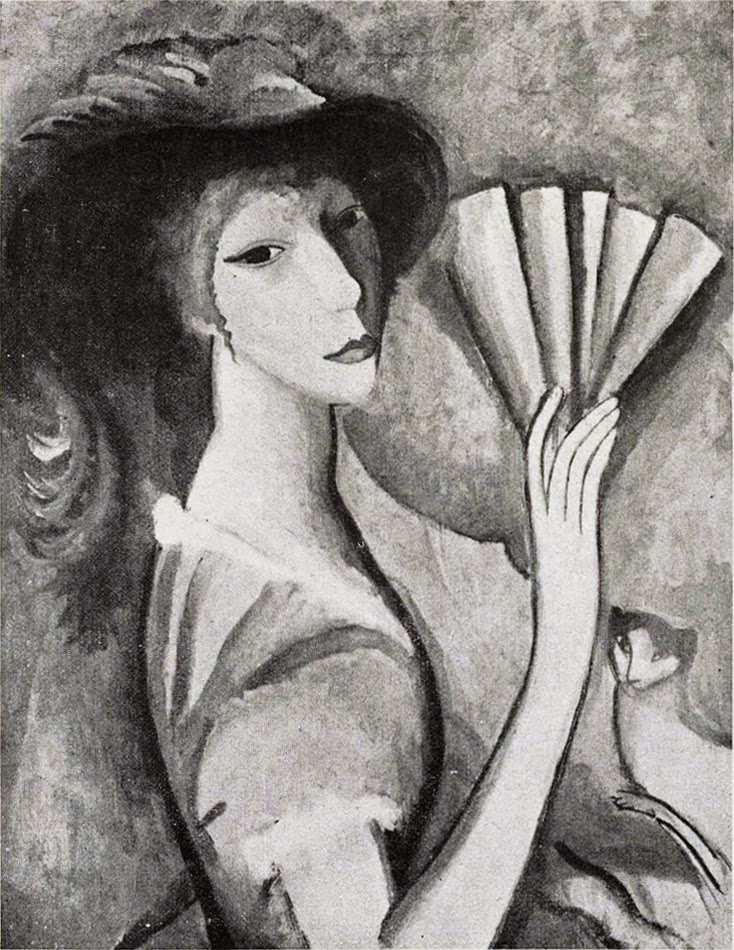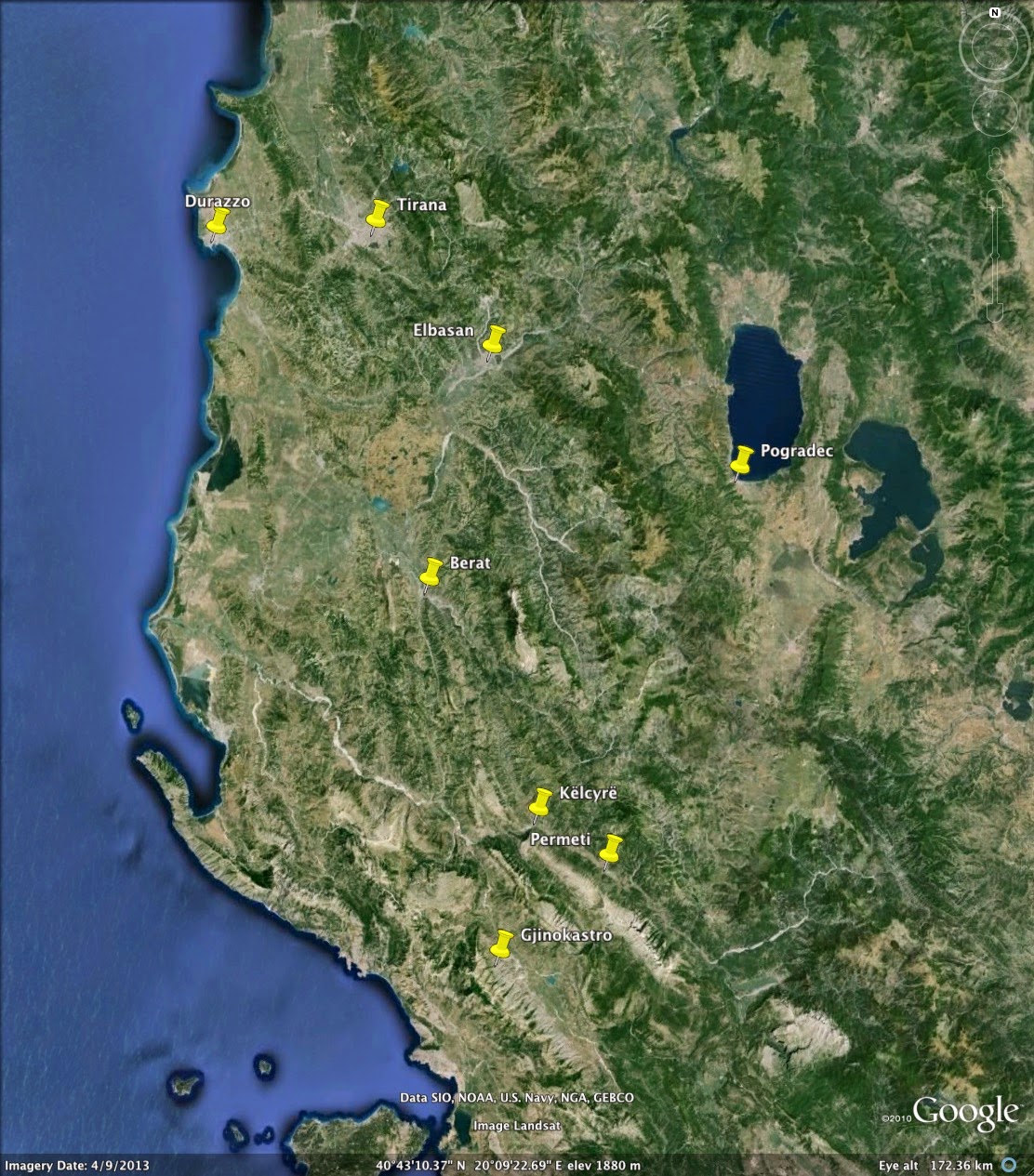Jan and Cora Gordon with Marie Laurencin in pre-WW1 Paris
In Jan Gordon's 1916 short article about pre-WW1 gatherings of Bohemian artists (himself and Cora Gordon included!) in Paris, there is a mention of "by no means least", Mlle. L--, "demure Normand, a governess, prim, modest, middle-aged during the daytime; but at night marvellously altered by a slight rake of the hat, and with a talent for brilliant repartee."
This was Marie Laurencin (1883-1956), whose mother was from Normandy. Her self portraits do suggest an air of prim modesty. One biography also observes that "it is difficult to envision the primly dressed, bourgeois-mannered young woman as an intimate of the aggressive, boisterous male artists and writers who comprised the inner sanctum of Pablo Picasso's studio, the Bateau-Lavoir, on the rue Ravignan in Montmartre." She was the only female artist associated with, and accepted by, the male-dominated, exclusive avant-garde art movements in early 20th-century Paris.
Her friend, the poet André Salmon (who was another acquaintance of Jan and Cora Gordon in pre-war Paris), wrote, "there is something of a fairy wand in the brush of Marie Laurencin." She was also known as Apollinaire's mistress and muse. Henri Rousseau painted the two of them together (1909) with the title "La muse inspirant le poète".
Around the time of those evenings with Paul Fort, André Salmon and others described by Jan Gordon, she exhibited at the Salon des Indépendants (1910-1911) and the Salon d'Automne (1911-1912).
Jan Gordon later wrote about Laurencin in his "Modern French Painters" (I'm reading from the copy once in the library of Steven Spurrier, which contains a wonderful inscription from Jan Gordon):
"Marie Laurencin's compositions have in them that sense of gracefully co-ordinated action which seems physically to differentiate the sexes. They have in them a gesture. They have a perfection of innate and interwoven movements which dance as lightly as ever danced a maiden before the alters of Aphrodite." "..these paintings of Marie Laurencin make one think of those impromptu tales which mothers invent for their children upon a winter's evening. Though they may appear inconsequent in the elements of the picture, they have a plot as straightforward as that of a fairy tale."
This was Marie Laurencin (1883-1956), whose mother was from Normandy. Her self portraits do suggest an air of prim modesty. One biography also observes that "it is difficult to envision the primly dressed, bourgeois-mannered young woman as an intimate of the aggressive, boisterous male artists and writers who comprised the inner sanctum of Pablo Picasso's studio, the Bateau-Lavoir, on the rue Ravignan in Montmartre." She was the only female artist associated with, and accepted by, the male-dominated, exclusive avant-garde art movements in early 20th-century Paris.
Her friend, the poet André Salmon (who was another acquaintance of Jan and Cora Gordon in pre-war Paris), wrote, "there is something of a fairy wand in the brush of Marie Laurencin." She was also known as Apollinaire's mistress and muse. Henri Rousseau painted the two of them together (1909) with the title "La muse inspirant le poète".
Self portrait by Marie Laurencin showing the "slight rake of the hat" noted by Jan Gordon.
Femme à l'éventail (Woman with a Fan), black and white photograph published in Albert Gleizes, Jean Metzinger, Du "Cubisme", Edition Figuière, Paris, 1912 (Wikimedia Commons).
Jan Gordon later wrote about Laurencin in his "Modern French Painters" (I'm reading from the copy once in the library of Steven Spurrier, which contains a wonderful inscription from Jan Gordon):
"Marie Laurencin's compositions have in them that sense of gracefully co-ordinated action which seems physically to differentiate the sexes. They have in them a gesture. They have a perfection of innate and interwoven movements which dance as lightly as ever danced a maiden before the alters of Aphrodite." "..these paintings of Marie Laurencin make one think of those impromptu tales which mothers invent for their children upon a winter's evening. Though they may appear inconsequent in the elements of the picture, they have a plot as straightforward as that of a fairy tale."
Gordon continues, "Here is an art which is feminine without being frivolous and free without being masculine. It represents the first purely feminine manifestation in the plastic arts. Marie Laurencin is as much an innovator as Matisse." High praise!
"Her line undoubtedly derives much from the Negro art - that simplified source of so much of the direct expression of personal vitality of to-day - and something from Botticelli. Her colouring is purely her own. It is said that the most difficult task for the painter is to produce beautiful greys. Marie Laurencin's silvery tints can only be called neutral because they are greys, but they seem to imply a new gamut of unpaintable colours, and they give an exquisite quality to the reds and blues which she contrasts with them."
Francis Carco also writes about Marie Laurencin in his "The Last Bohemia" (1928): "Any one who has ever known Marie Laurencin without becoming attached to her forever, is a monster, for she certainly is the most charming and most sprightly of friends. Her gaiety, her charm, her talent would move hearts of stone. And besides she had the prestige of having been bitter and sweet to our friend Guillaume [Apollinaire] and of having inspired his most beautiful poem."
Jan Gordon never mentions his personal acquaintanceship with the artists he writes about in "Modern French Painters" (1923), but I am delighted at every revelation of these personal connections that results from deciphering the semi-anonymised accounts in his other writings. Enjoyably this article is the first to reveal the connection between the Gordons and Marie Laurencin and there are several more identities of celebrated Bohemian friends of Jan and Cora Gordon yet to be shared.





Comments
Post a Comment